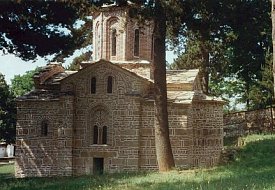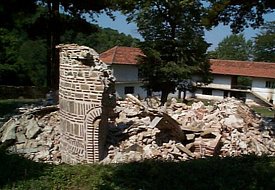 |
NATO's 50th Birthday Dinner
A wolf came upon a lamb straying from the flock, and felt some compunction about taking the life of so helpless a creature without some plausible excuse; so he cast about for a grievance and said at last,
"Last year, you grossly insulted me."
"That is impossible, sir," bleated the lamb, "for I wasn't born then."
"Well," retorted the wolf, "you feed in my pastures."
"That cannot be," replied the lamb, "for I have never yet tasted grass."
"You drink from my spring, then," continued the wolf.
"Indeed, sir," said the poor lamb, "I have never yet drunk anything but my mother's milk."
"Well, anyhow," said the wolf, "I'm not going without my dinner": and he sprang upon the lamb and devoured it without more ado.
- "The Wolf and the Lamb" by Aesop
|
 |

|
Even before the American-led elimination of Kossovo's 250,000 non-Albanians had been completed, that region's priceless collection of medieval churches and monasteries had begun to be destroyed. Many of these buildings were exceptionally important, not only for their intrinsic beauty, but because they were a bridge between the medieval architecture of eastern Europe and western Europe - between the Byzantine and the Romanesque styles.

The Serbian church of the Holy Virgin, near Suva Reka, Prizren, built in 1315 |

|

The same church after its destruction by explosives in July 1999
|
By the end of 1999 at least 55 Serbian Orthodox churches had been demolished or badly damaged according to NATO's own figures - the figure was over 70 according to Serbian sources. To date (August 2000) the official (NATO) figure is over 100 churches destroyed or seriously damaged. Other non-Albanian monuments - such as graveyards, statues, war memorials - have also been levelled. There have also been reports of historic Ottoman mosques and graveyards in Kossovo being destroyed by Saudi-backed Islamic fundamentalists who consider them to be creations of an "impure" branch of Islam.
NATO / KFOR troops in Kossovo have done nothing to prevent this destruction and have not arrested or even identified a single individual responsible. There is little doubt that NATO secretly supports this policy of cultural genocide; the destruction is necessary to ensure the permanent elimination of the Serbian population from Kossovo. In a few instances the policy has been revealed publicly - such as the case of a Finnish NATO officer (a colonel Arto Raty) who reportedly told journalists that if a church was not especially valuable historically then it should be demolished "quietly".
There is nothing surprising about all this, given that exactly the same thing has happened under similar circumstances in other parts of the world: such as to Greek cultural monuments in northern Cyprus after the elimination of its Greek population following the 1975 Turkish "intervention" and (as the many examples on this website reveal) to Armenian cultural monuments within Turkey after the Armenian Genocide. The destruction of Serbian monuments in Kossovo is an intrinsic part of a wider campaign for the total and permanent destruction of the Serbian population of Kossovo, making it easier for NATO to withdraw from Kossovo by leaving behind an ethnically-pure Albanian population, with its leaders bought and paid for by America, and with no "inconvenient" minorities to bother about. The fate of these buildings (along with Kossovo's non-Albanian population) was sealed the moment NATO bombs began to fall.
Article 2 of the United Nations' Convention on the Prevention and
Punishment of the Crime of Genocide provides definitions of genocide,
one of which is "deliberately inflicting on the group conditions of
life calculated to bring about its physical destruction in whole or in part". An incomplete listing (up to the end of 1999) of churches destroyed in Kossovo since NATO's invasion
- The Medieval Holy Trinity Monastery near Musutiste (Suva Reka), from the 14th century, with frescoes: plundered, set on fire, then completely destroyed by explosives.
- The Medieval church of Dormition of the Mother of God, in Musutiste, built in 1315, painted with frescoes: set on fire and later torn down.
- The Medieval St. Mark's Monastery, near Korisa, Prizren, built in 1467: looted, set on fire, and later totally destroyed by explosives.
- The Medieval Monastery of the Archangel Gabriel, in Binac village near Vitina, dating from 14th century, painted with frescoes: looted and set on fire.
- The Medieval Monastery of St. Joannicius of Devic, near Srbica, from the 15th century, painted with frescoes: looted and demolished.
- The Monastery of Dormition - St. Uros, Gornja Nerodimlja, dating from the 14th century, reconstructed in 1996: blown up with a mine and torn down.
- The Monastery of St. Archangel, Gornja Nerodimlja, dating from the 14th century, with frescoes, reconstructed in the 17th Century: set on fire and blown up with a mine, the graveyard was destroyed, the pine tree dating from 14th century was cut down and burned.
- St. Nicolas church, Donje Nerodimlje, an old church, reconstructed in 1983: set on fire, blown up with a mine, and demolished.
- St. Stephen's church , Donje Nerodimlje, situated in the graveyard, dating from the 14th century, reconstructed in 1996: set on fire, blown up with a mine, and demolished.
- The Presentation of the Virgin church in Dolac near Klina, built in 1620, with frescoes: burned, the Holy Throne destroyed, afterwards mined and demolished using explosives.
- St. Nicola s church in Slovinje village near Lipljan, founded in the 16th century, reconstructed in the 19th century: utterly destroyed by explosives.
- Holy Apostles Peter and Paul church in Suva Reka, dating from 1938: demolished and afterwards razed by explosives.
- The Holy Trinity church in Petric village, near Pec, from 1993: destroyed by explosives.
- The Presentation of the Virgin church in Belo Polje, near Pec, dating from the 16th century, reconstructed in the 19th century: demolished and set on fire.
- The Cathedral of St. Uros in Urosevac, built in 1933: demolished after its interior was set on fire.
- The church of St. Elijah the Prophet, in Vucitrn, built in 1834: plundered, demolished and partly burned.
- The church of St. John the Baptist, Samodreza, near Vucitrn, an old church, reconstructed in 1932: set on fire, demolished and torn down.
- St. Parasceva (St. Nicolas) church in Drsnik near Pec, dating from 16th century, with frescoes: ruined, its interior set on fire.
- The church of the Most Holy Mother of God in Naklo village, near Pec, from 1985: destroyed and burned.
- The Holy Trinity church in Velika Reka village, near Vucitrn, dating from 1997: demolished, set on fire and nearly destroyed.
- The Holy Apostles church in Petrovce village, near Kosovska Kamenica: set on fire and demolished.
- The church of the Most Holy Mother of God in Podgorce village, near Vitina: burned and demolished.
- The church of St. John the Baptist, in Pecka Banja, near Pec, from 1996: demolished, its interior set on fire.
- The church of the Most Holy Mother of God in Djurakovac, near Pec, built in 1997: demolished.
- The Cathedral of the Holy Trinity, in Djakovica, built in 1998: vandalized, its interior set on fire, the mosaic over the entrance destroyed, later completely razed by explosives (on July 24-25, 1999).
- St. Nicolas church in Osojane village, near Pec: demolished.
- The church of St. Elijah the Prophet in Bistrazin, between Prizren and Djakovica, reconstructed on the old foundations before 1941, during World War II it was destroyed by Albanian fascists, reconstructed for the second time in 1988: now completely demolished.
- St. Demetrius church in Siga, near Pec, reconstructed in 1937 on the medieval foundations: completely razed.
- St. Elijah church in Zegra village, near Gnjilane, dating from 1931: demolished and then completely burned down; the roof collapsed. Also, two church buildings were set on fire, and crosses and tombs in the graveyard were destroyed.
- The church of the Holy Unmercenaries, Novake - Prizren, an old church, reconstructed in 1991: demolished and set on fire, the tombs around the church ruined.
- The parish church in Krusevo, near Pec, an old church but reconstructed: broken into and partially burned.
- The Monastery of Saints. Cosma and Damian, the Unmercenary Healers, in Zociste, dating from the 14th century, with frescoes: looted and demolished, the greater part of the residential building burned.
- The parish church of St. John, in Grmovo, near Vitina: first set on fire, then completely destroyed by explosives (on July 25, 1999).
- St. Nicolas church in Kijevo, near Klina, built in the 14th century, painted with frescoes: leveled to the ground, crosses and tombs in the graveyard ruined.
- The church of St. Mark, the Evangelist, in Klina - Metohia, built on the foundations of the old church of Presentation of the Virgin: destroyed with explosives.
- St. Nicolas church in Ljubizda, near Prizren, dating from the 16th century: plundered and demolished; the parish center was set on fire.
- In the same village of Ljubizda, the church of St. Elijah the Prophet, dating from the 16th - 17th century, situated in the graveyard, reconstructed on the old foundations: looted, demolished, its interior set on fire, mined, the graveyard around it destroyed.
- St. Petkas church, in Dobrcane village, between Gnjilane and Kamenica: burned, the roof collapsed.
- The Cathedral of Christ the Saviour in Pristina, a new church: first there were attempts to set it on fire; later, on August 1, 1999, explosives were placed at four locations: two mines exploded but the other two did not.
- St. Elijah church, Smac village, near Prizren, a new church from 1994: set on fire, demolished, its interior mined, but not all the explosives exploded.
Since the above list was assembled there are now several web-sites available that give more comprehensive information, including "before" and "after" photographs:
See www.decani.yunet.com/destruction.html (the source for the two photographs on this page) and also www.balkanpiece.org/destruct/index.shtml. www.decani.yunet.com/destroyedchurch.html has a continuation of the list give above, with an additional 40 destroyed churches.
This website, VirtualANI, first went on-line on the
day that NATO bombs began to fall on Yugoslavia.
|